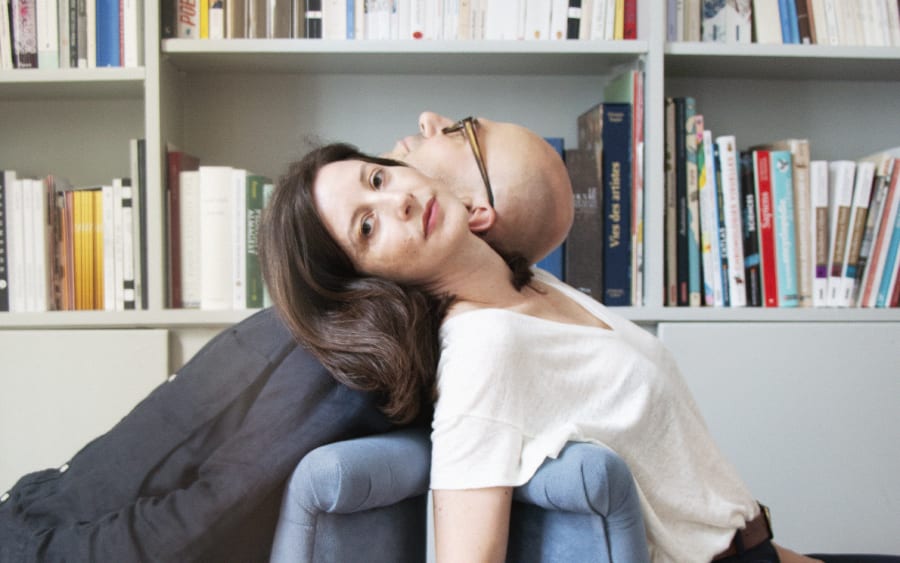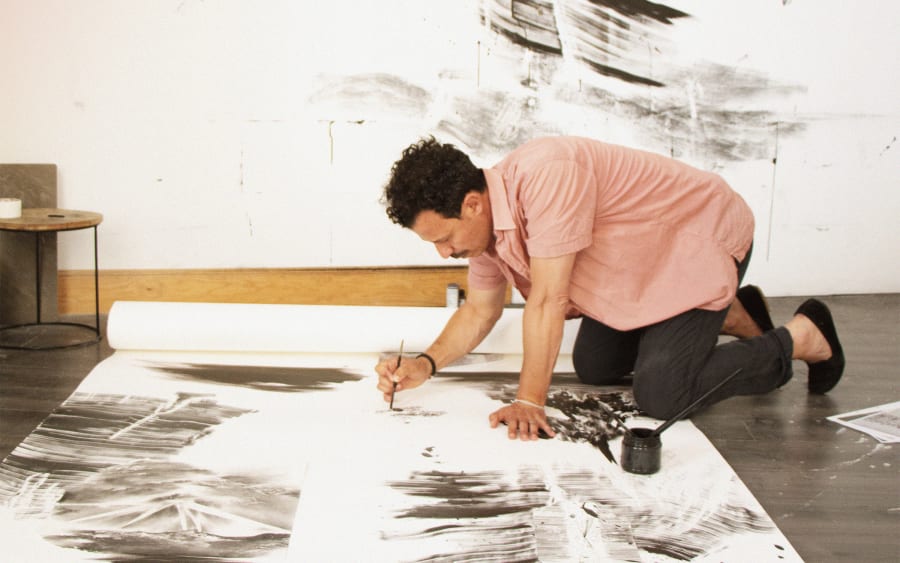In collaboration with the Centre Pompidou
In the 20th century, the level of the Mediterranean Sea rose by almost 20 cm. In only 2 years, the summit of Mont Blanc fell by 2 cm. As for the forest of Fontainebleau, its surface area has significantly increased since the mid-19th century. These geological changes have been recorded by precise measurements but are difficult to observe with the naked eye. Could we, perhaps, turn to art in order to represent these transformations of our planet that extend beyond human temporality? This is the ambition of Noémie Goudal, one of the four finalists for the prix Marcel Duchamp 2024.
In two new films, the French visual artist born in 1984, stages the destruction of a landscape. In the first, the rocks of a dark cave explode into a thousand pieces in slow motion, revealing shafts of light. In the second, trees liquefy, stripping away the forest they once constituted. Within a few minutes, Goudal baffles the perception of the viewer, who gradually comes to understand the subterfuge: We are not witnessing the disintegration of nature itself, but of large-scale images subjected to phenomena orchestrated by the artist. Goudal has been perfecting this striking new example of trompe-l’oeil art for the last 10 years, first through photography and more recently in video.
The origins of Goudal’s work date back to her time as a student, and more specifically to a trip to Scotland. Frustrated at not being able to capture the power of the surrounding landscape with just her camera, she had the idea to print a large photograph of a local road in her studio. She achieved the immersive effect she was looking for by placing objects or people in front of this print. Two aspects quickly became fundamental to her work: the materiality of the image, through its printing and recomposition in front of the lens, and the mise en abyme of the landscape, through these cobbled-together settings.
While many artists of her generation would use Photoshop to create similar montages, Goudal prefers her more artisanal method, breaking down the different strata of the image to recompose it in a way that plays on perspective and anamorphosis. She generally prints her photographs in an A3 format, cuts them and glues them together to form her backgrounds, before fixing them to wooden structures or hanging them from scaffolding. Everything starts with the position of the camera, which determines the setting’s placement in space. In the ‘Southern Light Stations’ series (2015), for example, spheres, filled with clouds, smoke, or the color of the sky, seem to float above expanses of sea or mountain valleys. Their seemingly spherical but actually flat surfaces reflect their surroundings, lending a surreal dimension to the work.
But a closer look at these images reveals traces of the artist’s hand with the wires and clothespins that hold together the edges of the paper collages. A simple oversight or a purposeful decision? ‘In my works, the viewer not only sees the landscapes but also the experience and the effort that went into making them,’ explains Goudal.
‘By leaving these flaws in, I am hoping that the viewer will understand that these landscapes are fake and wonder where the “real” lies. Is it in the whole that makes up the photograph or simply in the real setting where I install my prints?’ Goudal does not hesitate to reveal a behind-the-scenes look at this meticulous work on her Instagram account, showing the reverse sides of the two-dimensional collaged settings that blend into her works.
The Paris-based artist is focused on developing ‘a reflection on how landscape has been interpreted differently over the course of time and in different contexts, from antiquity to the industrial age, by way of the Middle Ages.’ Goudal does not need to travel to the other side of the world to give us a change of scenery and to invite contemplation. Most of her forests, caves, and rocky massifs are found in France, with a few exceptions, such as a palm grove in Spain (which looks more like a tropical jungle) or Brutalist buildings in India (which we might imagine finding in Eastern Europe). ‘Above all, I try to make the location and temporality of these settings hard to identify, so that everyone can project themselves into them,’ says Goudal.
Goudal is as interested in Copernicus and the deciphering of the sky before the invention of the telescope as she is in Buffon’s 18th-century theory on the history of the Earth. But above all else, she has been obsessed by paleoclimatology – the study of ancient climates – for several years. It is through this discipline that the artist seeks to retrace the evolution of the landscape without humans.
In 2022, she began to transcribe these evolutions through video. During the Rencontres d’Arles photography festival, she unveiled two films in the Église des Trinitaires: one of a jungle consumed by fire, revealing another setting behind it, and another of a forest transforming as its trees are submerged in a stream. For the first time, her sets are brought to life before the camera, while at the same time they surrender to the randomness of the actions she prompted.
Goudal continues to explore new territories through her project for the prix Marcel Duchamp. Now, she is surrounded by a film crew as though on a movie set, printing her landscapes on glass that she explodes with firecrackers, and on polystyrene that flames melt with a striking viscosity.
A few months after the presentation of these films at the Centre Pompidou, Goudal will inaugurate a colossal work at the new Blanc-Mesnil railway station, near Paris. The artist will use immense windows to stage a tropical greenhouse filled with exotic plants – some extinct since the Mesolithic period. Straddling not only the real and the fake, but also the past, present, and future, this permanent installation will remind viewers of one of art’s great powers: transcendence.
This article is part of a collaboration with the Centre Pompidou on the occasion of the prix Marcel Duchamp 2024.
Néomie Goudal is represented by Edel Assanti (London).
Prix Marcel Duchamp
Centre Pompidou, Paris
October 2, 2024 - January 6, 2025
Matthieu Jacquet is a writer based in Paris.
English translation: Centre
Pompidou.
All photographs by Aude Carleton for Art Basel.


